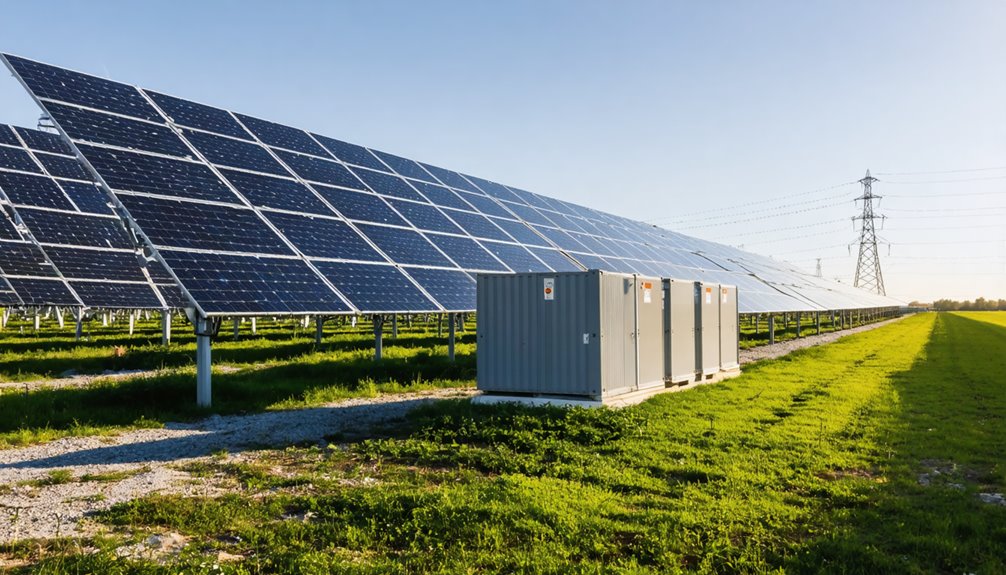Ground-mounted solar panel installations cost between $27,000 to over $60,000 for residential properties, with commercial systems starting at $150,000. Costs depend on factors like system size, land preparation, and inverter selection, where static systems or SMA inverters might reduce expenses compared to tracking systems or Enphase inverters. Larger systems, ideal for more energy output, require more extensive preparations and investments. Panel efficiency and installation complexity also influence pricing. Access long-term savings and financial incentives by understanding all aspects thoroughly.
Overview of Ground-Mounted Solar Panels
Ground-mounted solar panels present a viable solution for harnessing solar energy, especially on properties with ample land and ideal sun exposure. A Ground Mounted Solar Array can achieve greater energy production than rooftop systems due to its larger size and the ability to optimize the angle and direction to maximize solar efficiency. These configurations are flexible, allowing customization to meet specific energy requirements and adapt to unique property characteristics. Unlike rooftop solar panels, these systems can incorporate tracking mechanisms that enhance energy output by following the sun’s path throughout the day. Additionally, their installation and maintenance are more accessible, offering straightforward servicing and cleaning, ultimately leading to increased operational efficiency and longevity. This guarantees thorough use of solar energy, maximizing potential returns. This enables greater siting flexibility siting flexibility and easier expansion to meet evolving energy targets.
Key Factors Affecting Solar Panel Costs
With the advantages of ground-mounted solar panels outlined, understanding the cost factors becomes imperative for potential adopters. The cost of a Ground-Mount Solar System ranges greatly due to several variables. System size is a primary determinant; larger setups require more panels and complex installations, driving up expenses. Initial costs also rise with land preparation, permits, and electrical work, necessary components that rooftop systems might avoid. Furthermore, while static systems are typically less expensive, tracking systems offer enhanced solar power efficiency, albeit at the cost of higher installation and upkeep fees. Additionally, brand choice affects the overall expense; top-tier solar panels, though pricier, provide better efficiency and warranty benefits, adding to the long-term value despite the increased upfront investment. A thorough site assessment underpins optimal panel orientation and spacing, taking wind loading into account wind loading.
Comparing Ground-Mount and Roof-Mount Costs
When comparing ground-mounted and roof-mounted solar systems, you’ll find that ground mounts generally incur higher costs due to the need for independent support structures and increased labor expenses associated with posts and beams, as opposed to rooftop systems that utilize existing structures. The installation complexity of ground-mounted systems further elevates costs, given the necessity for additional site preparation and potentially extensive groundwork, which contrasts with the more straightforward installation process for rooftop systems. Despite the higher upfront costs, ground mounts offer flexibility in positioning for ideal sun exposure, which can increase energy production compared to the limitations posed by a roof’s size and orientation. Considering structural engineering requirements can prevent costly failures and ensure long-term safety.
Cost Differences Explained
Although ground-mounted solar systems generally incur higher initial expenses than their roof-mounted counterparts, understanding these cost differences necessitates an examination of both material and installation requirements. Ground-Mounted Solar Panels require additional support structures, like posts and beams, increasing both labor and material costs. Residential installations might range from $27,000 to over $60,000, while commercial systems could start at $150,000. Furthermore, land preparation and zoning compliance contribute to higher costs, unlike utilizing an existing rooftop. However, despite these upfront costs, ground-mounted systems offer flexibility in placement, ensuring ideal sun exposure which can greatly improve energy production. Subsequently, these systems can meet varying energy needs more efficiently. In the long run, lower maintenance expenses and prolonged durability can justify the initial investment.
Installation Complexity Comparison
Ground-mounted solar systems come with a higher complexity in installation compared to roof-mounted systems, primarily due to the need for constructing independent support infrastructures like posts and beams that aren’t necessary for rooftop configurations which benefit from the building’s existing structural framework. This installation complexity results in a significant amount of extra labor and materials. In addition to higher upfront costs, ground-mounted solar systems might face zoning or land-use regulations, further increasing overall complexity. However, ground mounts offer easier access for maintenance, promising potential long-term savings.
| Feature | Ground-Mount | Roof-Mount |
|---|---|---|
| Complexity | Higher | Lower |
| Initial Cost | Significant Amount | Less |
| Support Structures | Posts and Beams | Building Framework |
| Accessibility | Easier | Challenging |
| Regulatory Impact | Potentially Higher | Lower |
System Size Influence on Pricing
When considering the impact of system size on pricing, you should examine how panel wattage, labor costs, and inverter choices contribute to overall expenses. In ballast mounting scenarios, the ballast mounting approach can influence both material costs and wind-load considerations beyond a standard penetrative system. Higher wattage panels may lead to better efficiency but can increase initial costs, while labor expenses usually vary based on the complexity and scale of your installation. Additionally, the selection of inverters—whether opting for string inverters or microinverters—can greatly influence the total cost depending on the system’s design and energy needs.
Impact of Panel Wattage
As you consider the impact of panel wattage on pricing, you’ll find that the size of the solar panel system plays a significant role in determining the overall cost. The cost of ground-mounted solar panel systems typically aligns with their wattage, meaning larger systems result in higher upfront expenses. For example, a 50 kW system might cost between $150,000 and $500,000+ before incentives, whereas an 8.3 kW setup could be $13,194. Higher wattage systems, while more expensive initially, can generate more energy, offering substantial long-term savings on electricity bills. Federal tax credits and incentives further reduce the financial burden, making these installations attractive despite the higher initial investment. Ultimately, panel wattage directly influences both pricing and energy output.
Labor Costs Variation
Although the total expense of installing solar panels involves several factors, labor costs especially vary considerably depending on the system’s size. Larger systems typically entail higher labor expenses due to increased complexity and the extended time required for installation, as these often require more skilled labor hours. For residential projects, ground-mounted systems can cost between $27,000 and $60,000+, while larger commercial systems may range from $150,000 to $500,000+. These costs directly influence labor, with additional stability needs demanding more posts and beams. The design complexity of a custom system tailored to specific energy requirements can also impact labor costs. To fully understand potential labor expenses, seeking a Free Custom Quote can help, ensuring clarity on costs related to your specific system size and requirements.
Choice of Inverter
While labor costs certainly play a significant role in the overall expense of installing ground-mounted solar panels, the choice of inverter also exerts a considerable influence on system pricing. Inverter configurations lead to varied costs; for example, an 8.3 kW system with an Enphase inverter costs $13,194, contrasting with $10,470 for the same system using an SMA inverter. For larger systems, such as the 14.94 kW setup, prices range from $19,446 with SMA to $23,099 with Enphase. These differences underline how inverter type impacts pricing. Inverter choice affects compatibility with battery storage, potentially altering customization costs and influencing performance and warranty duration. Larger systems, like 29.7 kW, present complex pricing due to varying inverter technologies and intricate installation logistics.
Cost of Installing Residential Ground-Mount Systems
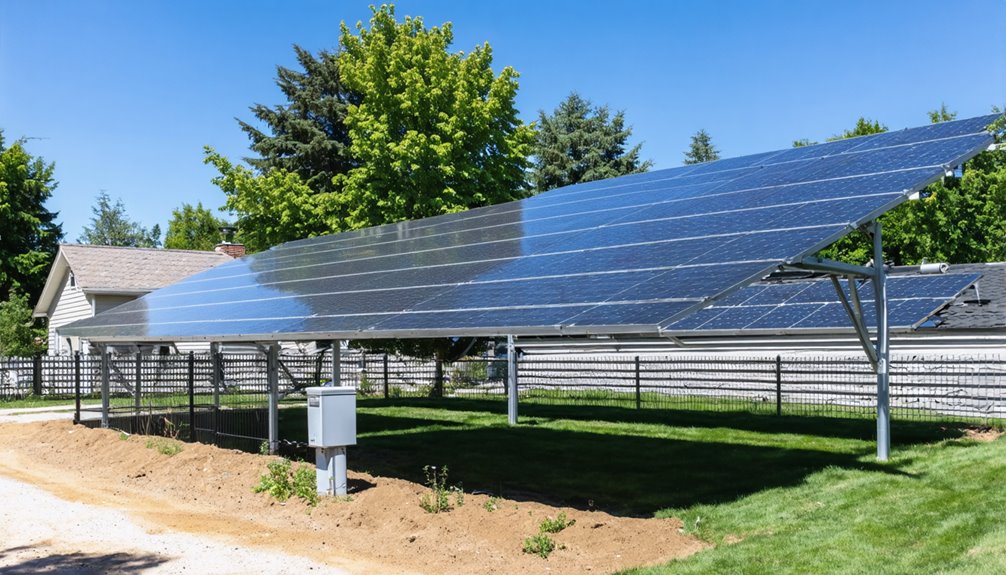
Installing residential ground-mounted solar systems involves a considerable financial outlay, with costs typically ranging from $27,000 to over $60,000, largely determined by system size and local installation expenses. Specific examples, such as a 50 kW system costing approximately $152,500, highlight the potential investment required for larger installations. Federal tax credits, however, can considerably decrease initial expenses, enhancing long-term affordability. Additional costs, including permits and electrical work, should be considered, as they add to installation complexity. The construction of independent support structures contributes to ground-mounted systems generally incurring higher upfront costs compared to rooftop alternatives. Here’s a concise overview:
| System Size | Estimated Cost | Additional Costs |
|---|---|---|
| 50 kW | $152,500 | Permits, Electrical Work |
| 100 kW | $276,800 | Land Preparation |
| 200 kW | $506,400 | Support Structures |
Commercial Ground-Mount Solar System Costs
Residential ground-mounted solar systems bear a substantial initial cost, yet they pave the way for exploring the potential of commercial installations. When considering installing a commercial ground-mounted solar system, expenses generally range from $150,000 to over $500,000, largely influenced by desired system capacity and energy needs. For instance, a standard 50 kW system might cost approximately $152,500, whereas a 100 kW system could reach around $276,800. The price for a substantial 200 kW installation can climb to about $506,400 prior to any incentives. While location specifics, land preparation, and installation complexity add to costs, applying federal tax credits and depreciation can greatly reduce financial strain, enhancing the system’s affordability and long-term value for businesses seeking sustainable energy solutions.
Choosing the Right Equipment and Brands
Selecting the right equipment for a ground-mounted solar panel system is essential for maximizing efficiency and guaranteeing long-term investment security. The QCells Q.PEAK DUO ML-G10+ panels, rated at 415 Watts (STC), offer high performance due to their efficiency and robust design. Pairing these with a reliable racking system, like IronRidge Ground Mounts, guarantees durability and stability with certified wind/snow load capacities from +7000 Pa to -4000 Pa. To enhance system performance and reduce long-term energy costs, incorporating advanced energy storage solutions, such as the Enphase 10C Battery System or SolarEdge Home Battery, is beneficial. System configuration should match specific energy needs and site specifics, ranging from 8.40 kW to 29.7 kW, guaranteeing peak performance and efficiency. Additionally, selecting a compliant mounting solution that can adapt to varying site conditions is crucial for long-term efficiency, with Ground Mounts playing a central role in stability and ease of maintenance.
Role of Location and Installation Complexity
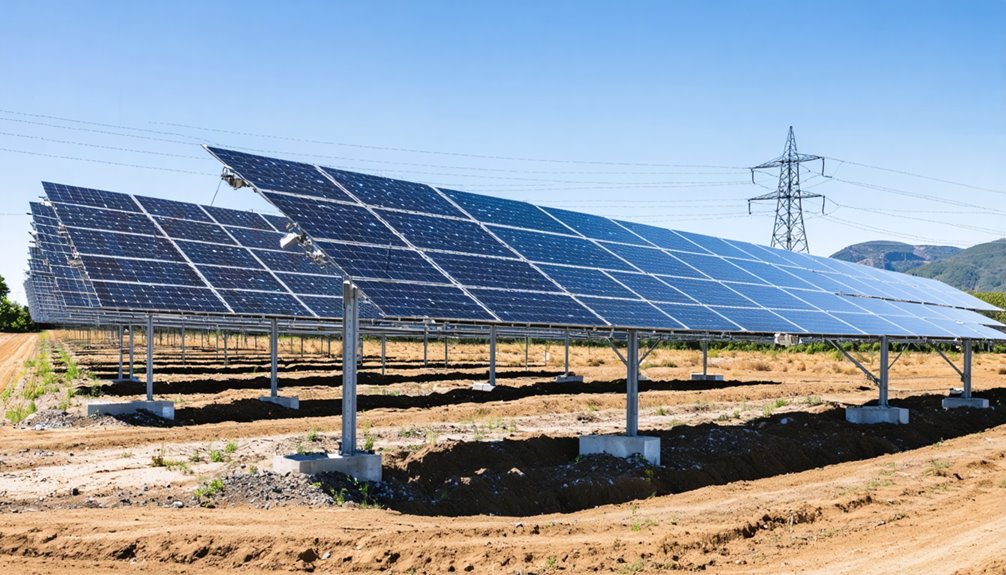
You’ll find that the cost of installing ground-mounted solar panels is heavily influenced by location-related factors such as local regulations and terrain implications, which can increase complexity. Local zoning and land-use regulations may not only dictate where installations can happen but also necessitate additional compliance steps, potentially escalating costs. Furthermore, if the terrain presents challenges, such as uneven surfaces or specific aesthetic requirements, the need for customized solutions can lead to higher material and labor expenses.
Local Regulations Impact
When undertaking the installation of ground-mounted solar panels, it is vital to take into account how local regulations and terrain complexity can profoundly influence both the feasibility and cost of your project. Local zoning laws and land-use regulations can impose restrictions, potentially complicating your installation plan and increasing costs. Additionally, regions with specific permitting processes might extend installation timelines and incur added expenses. Environmental considerations, such as wildlife protections or aesthetic regulations, could necessitate design modifications, adding to compliance costs. Moreover, areas with excellent solar resource availability might accommodate smaller, less costly systems, whereas regions with limited sunlight potentially require larger installations, increasing initial expenditures. Overall, understanding local regulatory impacts is significant in managing costs and streamlining your solar panel project.
Terrain Influences Costs
While installing ground-mounted solar panels, the terrain of the location plays a pivotal role in dictating installation costs and complexity. Uneven or rocky land requires additional site preparation and grading, considerably driving up expenses. Challenging access due to steep slopes or dense vegetation further increases labor costs due to installation difficulties. Variations in soil types directly affect the choice of mounting structures; sandy soils might necessitate deeper footings compared to stable, rocky grounds, leading to increased costs. Additionally, areas susceptible to extreme weather require more robust mounting systems, raising overall expenses. Moreover, zoning regulations or land-use restrictions might complicate installation permitting, potentially resulting in additional costs and delaying project timelines, thereby impacting the final cost of installing ground-mounted solar panels.
Importance of Land Preparation and Terrain Considerations
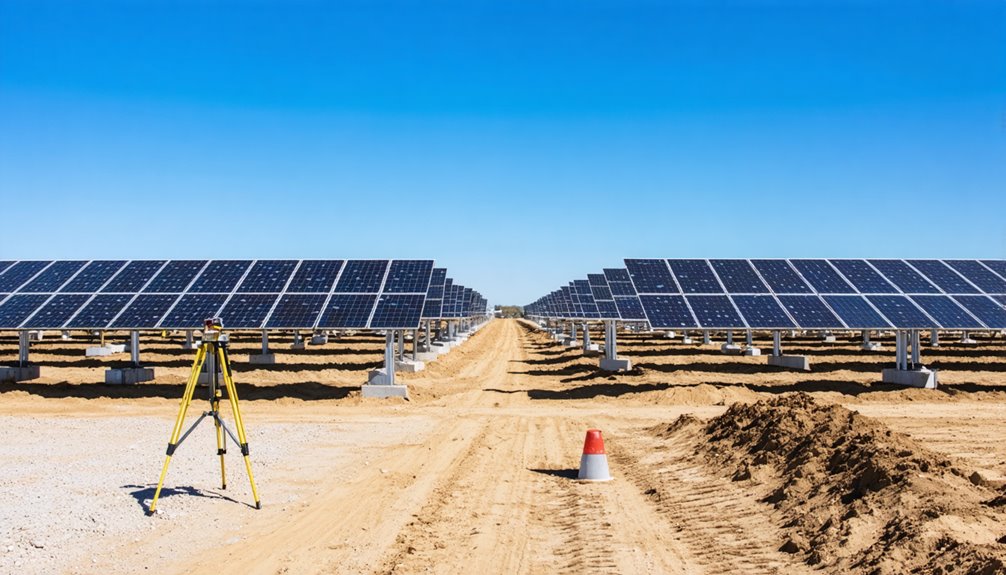
Before commencing the installation of ground-mounted solar panels, thorough land preparation and terrain analysis are crucial, as they directly influence both cost and structural stability. Grading the terrain may require heavy equipment and is contingent on the site’s condition. Terrain slope and stability affect design choices, dictating foundational needs and potentially increasing materials costs. Evaluating soil conditions, including load-bearing capacity and drainage, guarantees installation longevity and efficiency. Zoning laws and land-use regulations affect land preparation, setting parameters for system placement and installation methodology. Environmental assessments are necessary for minimizing ecosystem disruption, influencing costs and permitting durations. Each aspect is essential for a successful installation, informing planning and execution.
| Consideration | Impact | Requirements |
|---|---|---|
| Land Grading | Influences cost | May need heavy equipment |
| Terrain Slope/Stability | Affects design | Requires specific support structures |
| Soil Conditions | Determines foundation needs | Must assess load-bearing capacity |
| Zoning Regulations | Dictates preparation requirements | Compliance with laws required |
| Environmental Assessment | Reduces ecosystem disruption | thorough evaluation needed |
Long-Term Savings and Financial Incentives
Although installing ground-mounted solar panels requires a notable initial investment, the potential for long-term savings and financial incentives can make them an attractive option for many homeowners. You can see reductions in electricity bills from 50% to 90%, which considerably offsets initial costs over time. Federal tax credits, like the Investment Tax Credit (ITC), offer incentives of up to 26% of the system’s total cost, lessening the financial burden. Typically, you’ll experience a payback period of just 5 to 7 years, depending on local energy rates and available solar incentives. Local and state rebate programs, alongside performance-based incentives, further enhance savings and increase return on investment. These combined elements make ground-mounted solar systems a financially viable choice for many.
Maintenance Costs and Durability
Due to their robust construction and use of weather-resistant materials, ground-mounted solar panels demand minimal maintenance, considerably reducing long-term upkeep costs compared to conventional energy systems. Routine tasks, such as cleaning panels and inspecting racking systems, are straightforward and usually cost around $100 to $300 annually if contracted out. Unlike rooftop systems, ground-mounted installations are easily accessible, lowering labor costs associated with hard-to-reach areas. These systems boast a lifespan exceeding 25 years, underpinned by warranties that generally cover panels and racking for 10 to 25 years, ensuring sustained performance. While weather exposure might affect certain components, high-quality brands like QCells manufacture robust panels capable of enduring harsh conditions, contributing to their overall durability and longevity.
Environmental Impact of Ground-Mounted Solar
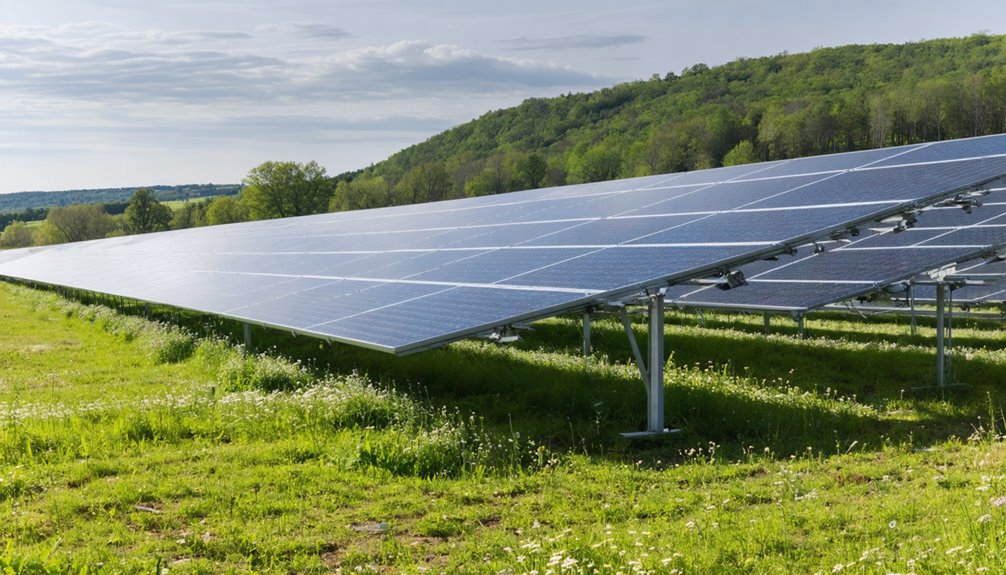
While ground-mounted solar panels present effective solutions for shifting to renewable energy, careful consideration of their environmental impact is essential. These installations, though efficient in maximizing sun exposure due to ideal land positioning, can potentially disrupt local ecosystems if not strategically planned. A thorough environmental impact assessment guarantees compliance with land-use regulations, minimizing adverse effects on habitats. However, when designed to coexist with wildlife, these systems may promote biodiversity, supporting habitats and fostering a beneficial balance between human activity and natural environments. Ground-mounted solar also plays a pivotal role in reducing carbon emissions, directly contributing to climate change mitigation efforts by decreasing reliance on fossil fuels. Therefore, their proper implementation supports sustainability and aligns with global environmental goals.
Determining the Worth of Ground-Mounted Systems
Ground-mounted solar panels not only have the potential to positively impact the environment but also present a strong case for their economic value. Although they require an initial investment ranging from $27,000 to over $60,000 for residential systems and $150,000 to $500,000+ for commercial ones, their benefits extend beyond cost alone. These systems’ flexibility allows you to install them in ideal sun-exposed locations, enhancing energy production compared to rooftop options. Furthermore, their accessibility for maintenance guarantees long-term efficiency. By accommodating larger panel arrays, ground-mounted systems increase energy generation and minimize shading issues, escalating their overall performance. Despite the higher upfront cost, they often result in long-term savings, lowering electricity bills and offering a substantial return on investment.
Conclusion
By understanding ground-mounted solar panels’ costs, including initial investment, installation intricacies, and ongoing maintenance, you can make informed decisions about their financial and environmental benefits. While upfront costs may be higher compared to roof-mounted systems, ground-mounted panels can offer significant long-term savings and access to various incentives. Evaluating factors like system size, site-specific conditions, and comparative costs ensures you maximize efficiency and returns, making them a viable option for residential solar power investments. The success of any ground-mounted solar installation depends significantly on the quality and reliability of the mounting systems used. Solocity Global serves as a trusted exporter of solar panel mounting systems, providing high-quality, standards-compliant mounting solutions to clients worldwide.

